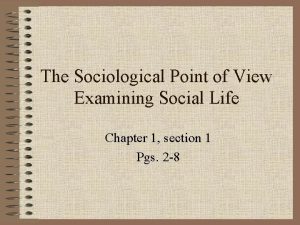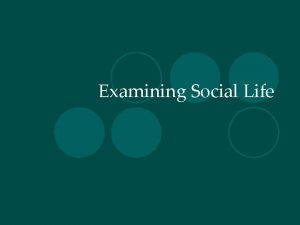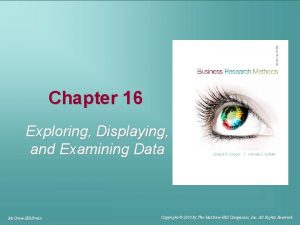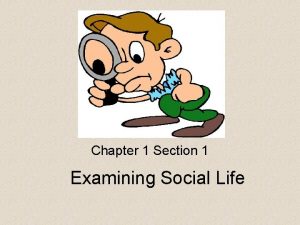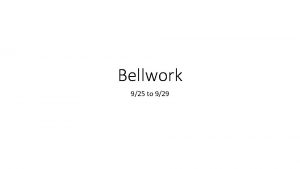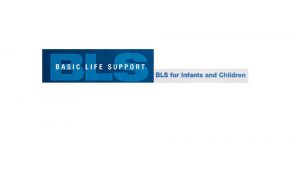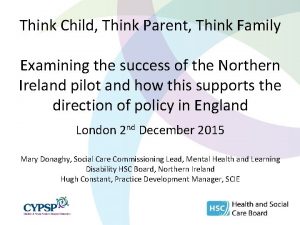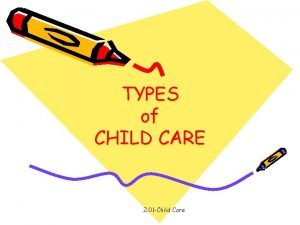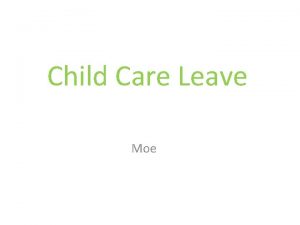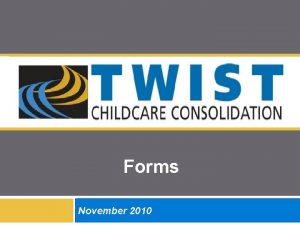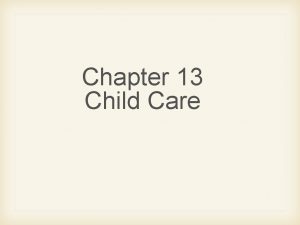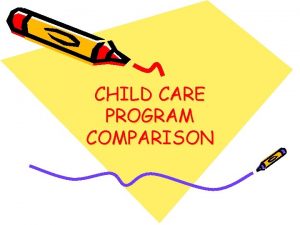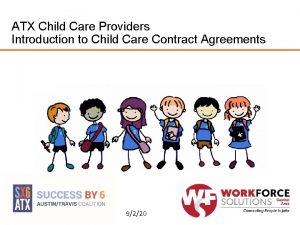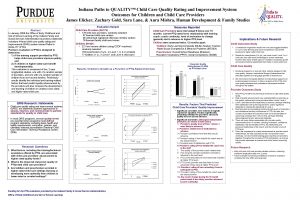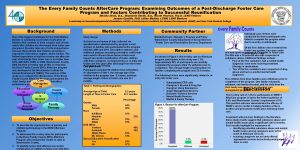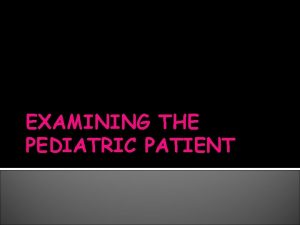Examining Quality in a Family Child Care Network















- Slides: 15

Examining Quality in a Family Child Care Network: An Evaluation of All Our Kin TONI PORTER EARLY CARE AND EDUCATION CONSULTING TONIBPORTER@GMAIL. COM

Research on Family Child Care Quality Initiatives • Limited research base on effectiveness. • Simple designs. • Small samples. Source: Porter, Paulsell, Avellar, Del Grosso, Hass & Vuong, 2010

Effective Strategies • • Primary service delivery strategies: – Coaching and consultation – Home visiting – Workshops – Professional development – Peer support Most initiatives supplement primary approaches with secondary strategies. Source: Paulsell et al. , 2010 3

4 Potential for Impact Type of Strategy Home-based technical assistance, professional development Training through workshops, support groups Materials Intensity High Intensity Moderate Intensity Low Intensity

Family Child Care Network Study Effective components: Frequent home visits Provider training at the network site Communication between staff and providers through network meetings Warm lines Source: Bromer, Van. Haitsma, Daley, & Modigliani, 2009

Early Evaluations 2007: Increased supply of family child care (Holt, Wexler, & Farnam, 2007). Self-reported increased income and educational levels (Waite et al. , 2011). Self-reported improved knowledge of child development, understanding of how to support cognitive, language and social-emotional development, and sense of professionalism (Weiser & Susman, 2013).

Research Questions: How does the quality of care that AOK family child care providers offer compare to the quality of care offered by family child care providers who are not affiliated with AOK ? What provider characteristics are associated with quality?

Study Design Target AOK FCC Sample Target Comparison FCC Providers Toolkit providers excluded 28 AOK providers who had a minimum of 7 consultation Hartford, Waterbury, visits, had participated in a Danbury, and New Britain minimum of 15 AOK activities, with 5 between October, 2012 and October, 2014 New Haven, Stamford, Norwalk, Bridgeport 20 FCC providers who had no prior contact with AOK

Results: Sample Characteristics No significant differences between AOK and non-AOK Race/ethnicity: 42% Latina, 33% Black Education: 31% some college, 40% undergraduate or graduate degree Specialized education in early childhood: 44 % none Income: 47 %, $35, 000 or below; 25%, $25, 000 or below Significant difference: CDA: p=. 020

Results: Average FCCERS Scores (. 000) 7 Average PICCOLO Scores (. 001) 60 6 50 5 40 4 30 3 20 2 10 1 0 0 AOK Comparison

FCCERS Subscales 7 6 5 Average Score 4 All Our Kin Comparison Group 3 2 1 0 Space and Furnishings Personal Listening and Care Talking Routines Activities Interaction Program Structure Parents and Provider

PICCOLO Subscales 14 12 10 Average Score 8 All Our Kin 6 Comparison Group 4 2 0 Affection Responsivness Encouragement Subscale Teaching

AOK Study Correlations with Quality FCCERS-R Education (. 333, p=<. 05) Intrinsic motivation (. 369, p=<. 05) Years planned to work (. 346, p=<. 05) Self-efficacy (. 326, p=<. 05) Job demands (-. 412, p=<. 01) Traditional beliefs (-. 387, p=<. 05) PICCOLO Education (. 451, p=<. 01)

Implications FCC networks with a variety of activities and trained staff have the potential to improve quality. Need to unpack the specific activities and/or combination of activities that contribute to quality. Need to better understand the influence that staff trained in relational practices have on quality improvement. Need to examine personal characteristics such as self-efficacy and social supports that may be related to quality.

References Bromer, J. , Van Haitsma, M. , Daley, K. , & Modigliani, K. (2009). Staffed support networks and quality in family child care: Findings from the family child care network impact study. Retrieved from Erikson Institute website: http: //www. erikson. edu/wpcontent/uploads/fccnetwork_execsummary 1. pdf Paulsell, D. , Porter, T. , Kirby, G. , Boller, K. , Martin, E. S. , Burwick, A. , & Ross, C. (2010). Supporting quality in home-based child care: Initiative design and evaluation options. Princeton, NJ: Mathematica Policy Research, Inc. Retrieved from: http: //www. acf. hhs. gov/sites/default/files/opre/supporting_options. pdf Porter, T. & Reiman, K. (2015). Examining quality in a family child care network: An evaluation of All Our Kin. Retrieved from All Our Kin website: http: //www. allourkin. org/sites/default/files/Examining. Qualityin. FCC 2016. pdf Porter, T. , Paulsell, D. , Del Grosso, P. , Avellar, S. , Hass, R. , & Vuong, L. (2010). A review of the literature on home-based child care: Implications for future directions. Princeton, NJ: Mathematica Policy Research. http: //www. acf. hhs. gov/sites/default/files/opre/lit_review. pdf
 Primary secondary tertiary care
Primary secondary tertiary care What is sociology perspective
What is sociology perspective Two people can have identical handwriting.
Two people can have identical handwriting. Sociology
Sociology Data preparing exploring examining and displaying
Data preparing exploring examining and displaying Examining social life practice
Examining social life practice Three principles of acquiring spiritual knowledge
Three principles of acquiring spiritual knowledge What conclusions can you make from examining the geochart?
What conclusions can you make from examining the geochart? 전위 순회
전위 순회 Objective of cpr
Objective of cpr Quality control and quality assurance
Quality control and quality assurance Pmp quality management
Pmp quality management Quality metrics pmp
Quality metrics pmp Ana model of quality assurance
Ana model of quality assurance Quality improvement vs quality assurance
Quality improvement vs quality assurance Quality control concepts
Quality control concepts

